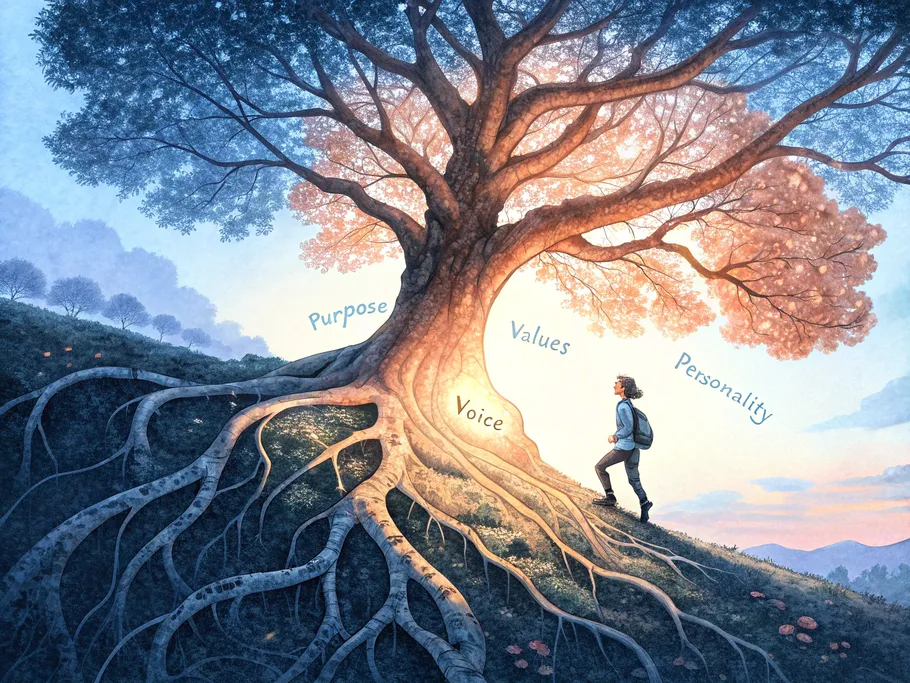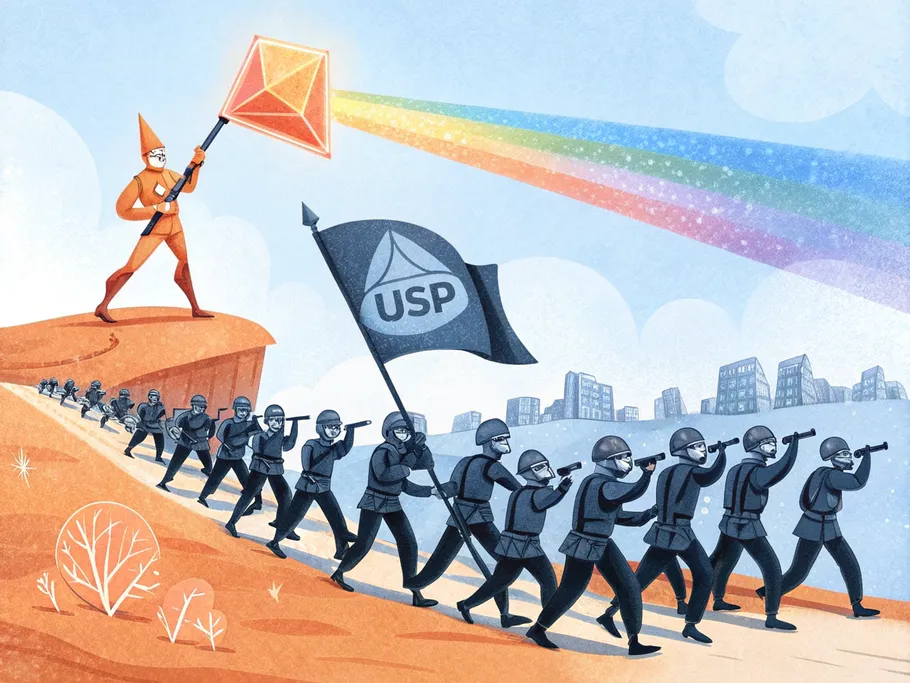Most founders think brand identity is about colors, logos, and Canva templates.
It’s not.
This is a way deeper conversation.
Brand identity is how your customer sees you, remembers you, and decides they trust you with their money.

It’s the difference between being “that startup that sort of does what X does” and “holy SHIT, where has this been all my life?”
So let’s build that kind of identity. One that gets remembered. Shared. Chosen.
After this article, you’ll nail your USP, figure out how you want to position yourself, you’ll have a killer brand story ready, and you’ll see how to best provide value to your customers.
All part of your brand identity.

Here’s the deal…
If a potential customer is comparing you and your competitor side by side, they’re looking for a reason NOT to choose you.
So your job is simple: give them a reason that makes their decision feel obvious.
Aka… Your Unique Selling Proposition (USP).
I know you’ve heard of this before, but damn, no one actually bothers to think about it. It’s not something you just “know” or something you can ask ChatGPT.
It’s a sharp, practical, brutally honest answer to this question:
“Why should someone pick you instead of literally anyone else?”
Think about it, really. You’re probably NOT the best. You’re NOT the cheapest (hopefully), so why the hell you?
Most people answer this by saying vague stuff like “quality,” “value,” or “customer service.”
But that isn’t a USP. That’s nothing because it’s not tangible.
Let me show you what to do instead:
Yes, do it manually. No, Master GPT cannot do it for you.
Start with:
And then… chart them visually.
Create a positioning map using two relevant axes — like price vs. quality, or simplicity vs. customization.
Then, look at how they’re clustered. Try and find a gap.
That’s your USP. That’s what you need to develop.
I swear, business is almost a ‘scientific’ process. You don’t need the perfect moment of inspiration – not at all.
You just need to take the right steps.
If you take more ‘right’ steps, you’ll progress. Make more ‘wrong’ steps, and you won’t progress.
And if you want to take more steps in the RIGHT direction, I recommend you use my Startup Launch Roadmap.
It’s an A-Z startup guide, where you’ll see how to get your product ‘launch ready’ and line up a queue of investors.
You can get it here:

There are two ways to communicate value:
Emotionally and rationally.
And you need to pick a lane. Of course, it’s not a rigid thing, but stay with me.
Let’s break them down:
This works best when your product is unique. For example, consultative services are hard to compare.
It’s how Apple sells you a laptop — not with specs, but with desire.
You’re not buying RAM. You’re buying elegance, speed, and that sexy trackpad glide.
If you’re in this category, you should…
Your goal is to make them feel something before they even think. Of course, you’ll use logic to rationalize the investment.
However, your goal is to sell them on a feeling.
Use this when you’re in a crowded space. You sell what others sell. But you sell it better, cheaper, faster.
(More carrots in the bag…)
Here, your weapon is LOGIC:
See, here you’re using NUMBERS to impact EMOTION. You want to make them feel safe and confident.
“Get XYZ done in half the time for 60% less within 3 months, or you get your money back.”
If you pick the wrong lane here, you’ll confuse people. And confused people don’t buy.
Okay, there are lots of branding strategies. Definitely.
But… to be honest…
You can’t build a great brand identity around a shitty or undifferentiated product.

At first, your product features ARE your brand.
But once competitors catch up and start copying you (they will), your brand has to carry the weight.
So before you drop $7K on a ‘brand guidelines’ course…
Ask yourself:
A strong brand doesn’t protect a bad product.
It magnifies whatever is already there.
That’s why Apple’s brand works. Their stuff actually delivers. Well, mostly 😛

Another one of those terms people like to throw around – but few really understand.
Positioning simply means “how your audience thinks of you”. It’s kind of a mental box they put you in.
Bad positioning makes you blend in.
Good positioning makes people think:
“Wait, this was built for people JUST like me!”
Let me give you an easy example:
❌ “Team communication app” — Good job, you’re one of 7,000 tools.
✅ “Internal comms tool for 10+ person real estate teams” — Okay, now I can see how this can help ME.
If you can’t be the biggest fish in the pond, make the pond smaller.
This process is also called “niching down”. It won’t limit your addressable market, unless you really go way too far.
But that’s rare. In reality, there are always ‘sub-niches’ you can tap into – so you never run out of customers.
Actionable Positioning Statement:
“We help [exact target audience] achieve [specific result] by [your unique approach or product].”
You can fill this out for your service, but also for your products. It’s not just an agency offer. Anything you sell is really for a specific person to get a result.
The more specific you are, the better. Rewrite it until it makes you uncomfortable how specific it is.
Let me guess:
Someone told you to “tell your story.”
And you thought, “Okay, I’ll write about how we started in my dorm room.”
Okay, inspiring… But why does that matter?
Your brand story isn’t really about you. It’s more about why your company exists in your customer’s world.
‘Cause remember, customers don’t care about you. They care about themselves. It’s just human nature. Before judging them, know that you’re also a customer.
Here’s what to include:
That’s the real story people buy into. That’s what makes your brand identity magnetic.
Trust is everything. Especially when you’re small, new, or unknown. And ESPECIALLY in the online world, where business owners get burned on the daily.
At the beginning, you won’t have too much proof.
So here’s how to borrow trust until you earn it:
Even if it’s just:
“This tool saved us 3 hours a day.” — Dave from LinkedIn
Literally take ANY wins you have. Whatever a client or customer comments, take a screenshot. Take ANYTHING that can help you gain some trust.
Put that sh*t on the homepage. The pricing page. The thank-you page. Every page.

Find non-competing brands your audience already trusts. Cross-promote. Co-host webinars. Share audiences.
This is really powerful. You can literally ‘borrow’ the customers that other brands have worked so hard to gain, and you can sell them your own offers.
Of course, you have to give something back – but it’s powerful, in any case.
You’ll gain borrowed credibility.
The more customers sing your praises, the farther your name will be heard. People trust people more than they trust logos.
Here are some ideas on how you can encourage that:
Brand identity is NOT about fonts and color palettes. That’s surface-level stuff. If you want to actually stand out (and stay top of mind), here’s what you need to take away from this article:

Email subscription is available ONLY TODAY (oh, okay, and tomorrow).
Surely, we respect your inbox! Unsubscription works every day.

We’d love to tailor your experience — which of these best describes you?